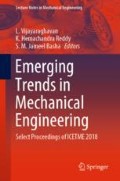Abstract
Optimization of process parameters is an important technique in machining sector. In the present work, an experimental study has been performed in turning of AISI D2 steel using coated carbide tool in dry and forced air-cooled environment. Taguchi’s orthogonal array L9 has been used for running the experiments considering cutting speed, feed rate and depth of cut as process parameters and surface roughness, flank wear and cutting force as performance parameters. To optimize the performance parameters together in a single setting, an overall evaluation criterion (OEC) has been used. Analysis of variance (ANOVA) and average performance value of OEC is also analyzed. It is found that from the predicted setting of the average performance value of OEC, the surface roughness, flank wear and cutting force is reduced in both dry turning (DT) and forced air-cooled turning (ACT) as compared to the optimum value obtained from the experimental run.
Access this chapter
Tax calculation will be finalised at checkout
Purchases are for personal use only
References
Bartarya G, Choudhury SK (2012) State of the art in hard turning. Int J Mach Tools Manuf 53(1):1–14
Shao H, Li L, Zhang SZ (2013) Study on machinability of stellite alloy with uncoated and coated carbide tools in turning. J Manuf Process 15(4):673–681
Strenkowski JS, Shih AJ, Lin JC (2002) An analytical finite element model for predicting three-dimensional tool forces and chip flow. Int J Mach Tools Manuf 42(6):723–731
Chou YK, Evans CJ, Barash MM (2002) Experimental investigation on CBM turning of hardened AISI 52100 steel. J Mater Process Technol 124(3):274–283
Lima JG, Avila RF, Abrao AM, Faustino M, Davim JP (2005) Hard turning: AISI 4340 high strength low alloy steel and AISI D2 cold work tool steel. J Mater Process Technol 169(3):388–395
Klocke F, Eisenblatte G (1997) Dry turning. CIRP Ann-Manuf Technol 46 (2):519–526
Weinert K, Inasaki I, Sutherland JW, Wakabayashi T (2004) Dry machining and minimum quantity lubrication. CIRP Ann-Manuf Technol 53(2):511–537
Dixit US, Sarma DK, Davim JP (2012) Environmentally friendly machining, 1st edn. Springer-Verlag, New York
Sarma DK, Dixit US (2007) A comparison of dry and air-cooled turning of grey cast iron with mixed oxide ceramic tool. J Mater Process Technol 190(1–3):160–172
Liu M, Chiang KT, Hung CM (2013) Modelling and analyzing the effects of air-cooled turning on the machinability of Ti-6Al-4 V titanium alloy using the cold air gun coolant system. Int J Adv Manuf Technol 67(5–8):1053–1066
Panda A, Sahoo AK, Rout AK (2016) Investigations on surface quality characteristics with multi-response parametric optimization and correlation. Alex Eng J 55:1625–1633
Das SR, Nayak RP, Dhupal D (2012) Optimization of cutting parameters on tool wear and work piece surface temperature in turning of AISI D2 steel. Int J Lean Think 3:140–156
Singh H, Kumar P (2004) Tool wear optimization in turning operation by Taguchi method. J Eng Mater Sci 11:19–24
Rajbongshi SK, Sarma DK (2019) Process parameters optimization using Taguchi’s orthogonal array and grey relational analysis during hard turning of AISI D2 steel in forced air-cooled condition. IOP Conf Ser: Mater Sci Eng 491(012032):1–6
Author information
Authors and Affiliations
Corresponding author
Editor information
Editors and Affiliations
Rights and permissions
Copyright information
© 2020 Springer Nature Singapore Pte Ltd.
About this paper
Cite this paper
Rajbongshi, S.K., Sarma, D.K. (2020). Application of Taguchi’s Orthogonal Array and Overall Evaluation Criteria in Turning of AISI D2 Steel in Dry and Forced Air-Cooled Environment. In: Vijayaraghavan, L., Reddy, K., Jameel Basha, S. (eds) Emerging Trends in Mechanical Engineering. Lecture Notes in Mechanical Engineering. Springer, Singapore. https://doi.org/10.1007/978-981-32-9931-3_18
Download citation
DOI: https://doi.org/10.1007/978-981-32-9931-3_18
Published:
Publisher Name: Springer, Singapore
Print ISBN: 978-981-32-9930-6
Online ISBN: 978-981-32-9931-3
eBook Packages: EngineeringEngineering (R0)

